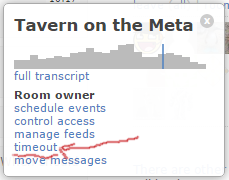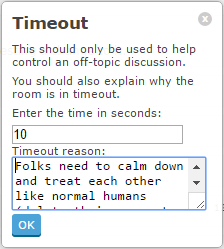## What tools are available to room owners? Room owners are users that have some elevated permissions in a chatroom. Typically, they will be the first line of defense when it comes to inappropriate content or behavior in a room. Users will look to the room owners to guide the room. The room owners are also able to perform moderation tasks without the need to involve a diamond moderator. As a room owner, there are several different ways you can keep your room in-line. ### Taking out the trash If unsuitable messages are being posted, then you have the ability to move the messages to the trash can. A “trash” (or “bin”) is just a room created for the sole purpose of holding unwanted messages. Users who have their messages binned aren’t punished but are implicitly encouraged to stop whatever they were doing. This keeps the transcript free of inappropriate, offensive, or spam messages. You can bin messages via the room↓ menu on the right side of the chatroom, then selecting move messages. > [![Move Messages][1]][1] By selecting move messages, you will be presented with batch operation popup to allow you move multiple messages at once. > [![batch popup][2]][2] By hovering over a message, you’ll see a large plus as the cursor which is the indication that the message will be added to the migration list. Selecting the message (by holding down <kbd>ctrl</kbd> you can select multiple messages) will highlight it and once all of the messages are selected, you can choose “relocate” which will allow you to choose the target trash room and the messages will be removed. > [![relocation][3]][3] This removes the messages from the main transcript. ### Kick-mute a troublesome user Should your room be graced with the presence of a user who is causing trouble, and they fail to respond to the guidance of the room owners and other participants, then you have the ability to [kick them out of the room for a period of time][4]. The kick-mute length increases with each instance: initially they will be kicked for 1 minute, then 5 minutes, then 30 minutes. After three kicks from the room, an automatic moderator flag is raised. The kick-mute option is available by clicking on the username and the following pop-up will be presented: > [![kick-mute][5]][5] A user who has been kick-muted will be removed from the room, and upon attempting to return, will see a message informing them that they must wait along with some guidance on how to behave in chat. [![][6]][6] A user who has been repeatedly kick-muted will lose the privilege to create chatrooms and will automatically have a moderator flag raised; this should normally serve to inform the moderators of a seriously disruptive person. *However,* in some cases a person may cause enough problems in chat to require moderator intervention before the three-kick-mute threshold is reached; in these instances, you can flag one of their messages for a moderator to review and step-in as needed. **Don’t be too reluctant to use kick-mute** – if you wait with kicking until everyone hates the person, they’re gonna have a hard time coming back *and* it may take too long to get a moderator involved. Kick at the first sign of trouble, and be ready to forgive and forget if they correct. Also note that kick-mutes are not announced to the room in general although other ROs will receive a banner notification; you may find it helpful to post “kicked” in order to reassure others in the room who have become agitated by the person being kicked. However, this is not required and if the conversation shows signs of moving on then you should generally allow it to do so. ### Putting the room in timeout Sometimes, *everyone* is being disruptive or inappropriate, or a disagreement among a subset of users threatens to polarize others and lead to non-constructive behavior. In these situations, it's helpful to put the room into a "timeout" and give everyone a chance to calm down and reflect on what they're doing.  Choosing the "timeout" option from the room menu presents you with a dialog asking for a *duration* and an *explanation*:  Both are mandatory. If you forget to enter a message, nothing will happen. (Note that **moderators** *can* impose a timeout without entering a message, in which case a default message will be displayed reminding folks to keep the room on-topic). Try to write a message that explains the problem you've observed and encourages people to reflect. Avoid messages that will further inflame tempers or that point fingers at individuals. Note that the message is limited to 100 characters. - **Good**: This conversation is getting heated - let's take a break and talk about something else. - **Bad**: Magisch ruined it for everyone. Now no one gets to talk. - **Good**: Conversation here should be relevant to SciFi enthusiasts; let's create a separate room for politics - **Bad**: Trump is awesome; if you disagree, GTFO. Once a message is entered and "OK" is pressed, the room will be in "timeout" mode: only room owners and moderators will be able to post messages; everyone else will see a countdown where the message input form normally sits. Also, the message explaining the timeout will appear in the transcript:  Once the timeout has expired, the input form will return and everyone will be able to resume conversation. Timeouts can be cancelled by imposing a new timeout that lasts 0 seconds. You'll then get to see a "Timeout cleared" message. Note that you still have to provide a timeout reason, even while it won't be displayed. ### Flagging messages and users Just like any other user of chat, you have the ability to flag messages for a moderator and/or flag messages as inappropriate, offensive or spam. Letting a moderator know when there’s a problem you can’t handle by yourself is a good way to ensure that they work *with* you rather than seeing you as part of the problem. Please read the guidance about *when* you should flag, in the [answer covering tools for regular users](https://meta.stackexchange.com/a/271268). ### Establish a room topic Use the room description to set boundaries what users can expect in the room or is expected from them when they join. If the guidance doesn't fit consider linking to a team page or an external hosted site. Adding tags can help in giving a room focus. When necessary, judicious use of short timeouts can help to reinforce the topic(s) allowed in the room. ### Lead by example The best way to prevent problems from arising is frequently to set a good example for others by conducting yourself in the way you’d want them to. If you are welcoming and friendly, that sets an expectation for those who join you. Conversely, if you’re casually vulgar and insulting, expect that anyone willing to hang around will be as well. This isn’t limited to room owners, of course... But as a frequent participant in the room, you may have a better ability than most to recognize when a problematic attitude is developing, and more opportunities to correct it in your own behavior. [1]: https://i.sstatic.net/7XuP4.png [2]: https://i.sstatic.net/uIISx.png [3]: https://i.sstatic.net/yjIhx.png [4]: https://meta.stackexchange.com/questions/229905/impose-a-re-entry-delay-on-users-kicked-out-of-a-chat-room/239226#239226 [5]: https://i.sstatic.net/qv6Ih.png [6]: https://i.sstatic.net/co3Im.png